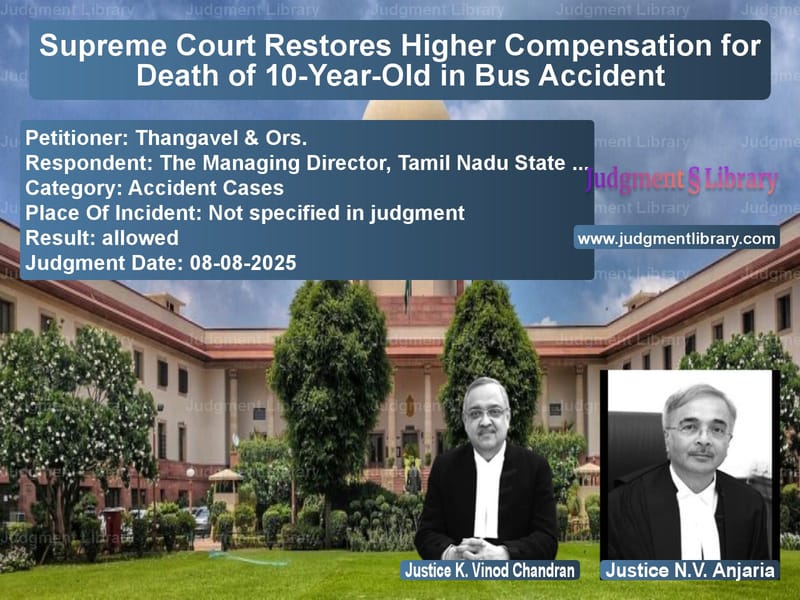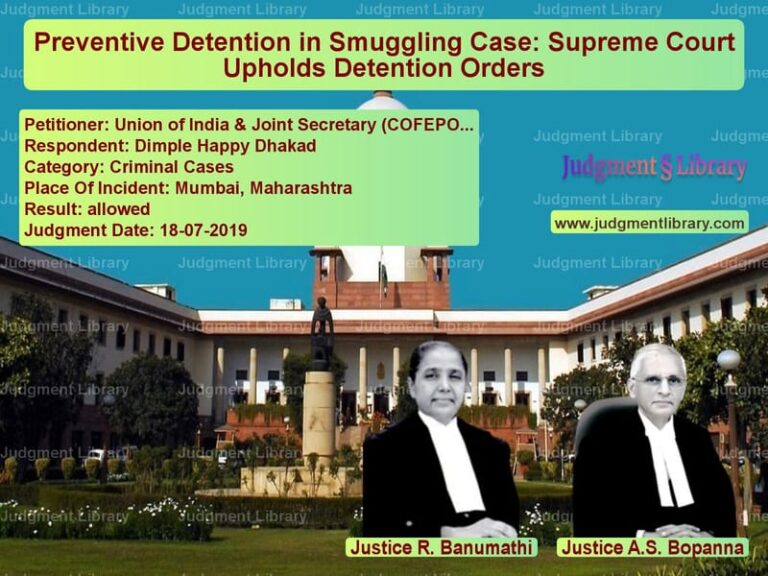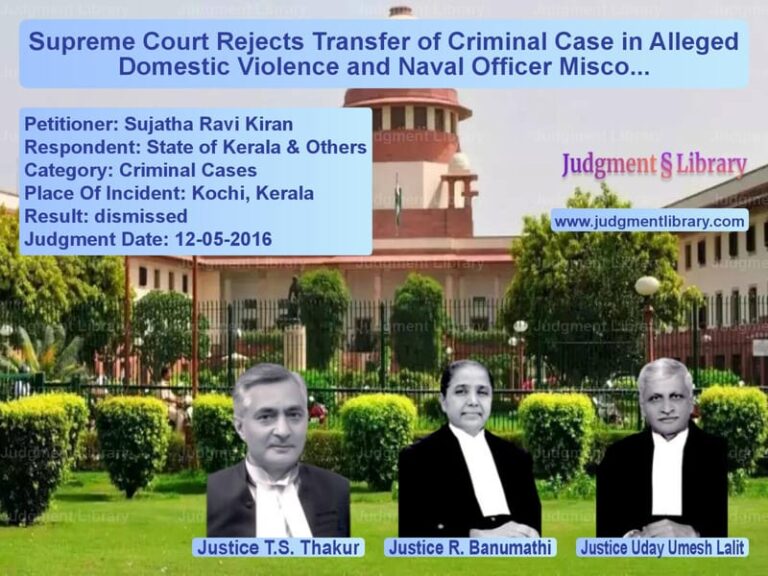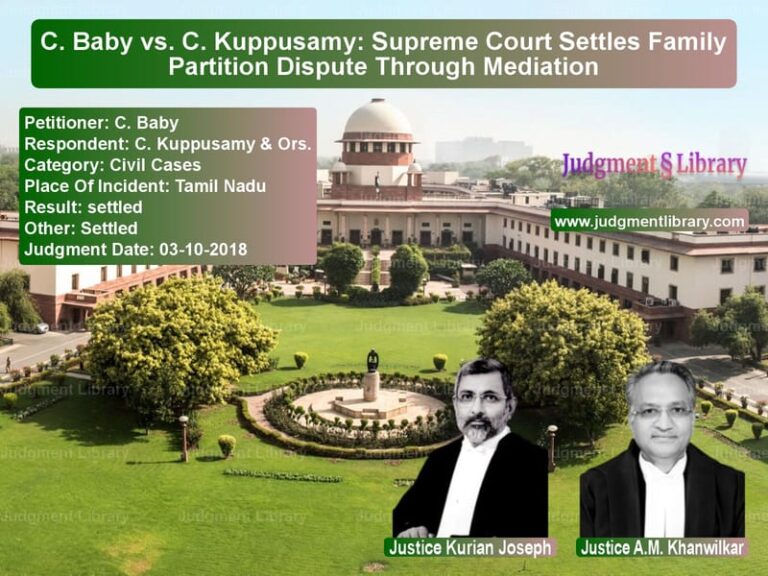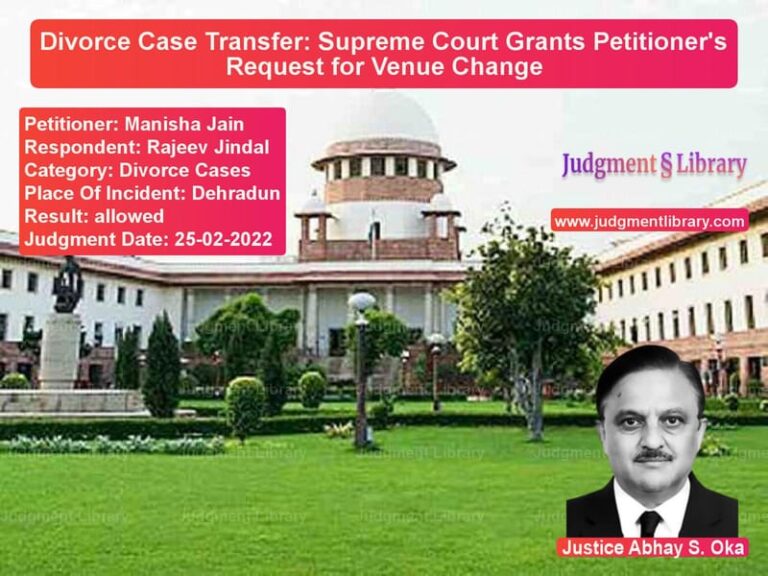Supreme Court Restores Higher Compensation for Death of 10-Year-Old in Bus Accident
In a significant judgment that brings relief to grieving parents, the Supreme Court has restored the higher compensation amount awarded by the Motor Accident Claims Tribunal for the death of a 10-year-old boy in a tragic bus accident. The case involved Thangavel and his wife, who had lost their young son when he was hit by a Tamil Nadu State Transport Corporation bus while cycling to school, and their legal battle to secure adequate compensation for their unimaginable loss.
The Tragic Accident and Initial Proceedings
The heartbreaking incident occurred when a 10-year-old boy was cycling to school and was hit by a bus belonging to the Tamil Nadu State Transport Corporation. There was no dispute about the negligence of the bus driver, and the case primarily revolved around the quantum of compensation that should be awarded to the grieving parents for the loss of their young son.
The Motor Accident Claims Tribunal had initially awarded a total compensation of Rs. 8,55,000 to the parents. The Tribunal calculated this amount by reckoning the child’s notional income at Rs. 5,000 per month and determining compensation for loss of dependency using a multiplier of 18, while deducting two-thirds for personal expenses. Additionally, the Tribunal granted Rs. 1,00,000 for loss of love and affection, Rs. 25,000 for funeral expenses, and Rs. 5,000 each for transportation and loss of dress, ornaments, and cycle.
The High Court’s Reduction of Compensation
The Madurai Bench of the Madras High Court, however, substantially reduced the compensation amount to Rs. 5,80,000. The High Court based its decision on Schedule II of the Motor Vehicles Act, 1988, adopting Rs. 30,000 per year as the notional income instead of the Rs. 5,000 per month (Rs. 60,000 per year) that the Tribunal had used. The High Court also reduced the multiplier from 18 to 15, considering the age of the mother.
While confirming the amount for loss of love and affection, the High Court reduced funeral expenses to Rs. 15,000 and completely deleted the amounts granted for transportation and damage to clothes and cycle. The High Court did add Rs. 15,000 for loss of estate, but the net effect was a significant reduction in the total compensation from Rs. 8,55,000 to Rs. 5,80,000.
The Supreme Court’s Legal Analysis
The Supreme Court bench comprising Justices K. Vinod Chandran and N.V. Anjaria carefully examined the legal principles governing compensation in cases involving children’s deaths in motor accidents. The Court made several crucial observations about the proper methodology for calculating compensation.
The Supreme Court noted: “There is no straight jacket formula as to the income to be adopted in the case of children when they suffer injuries or succumb to death, in a motor vehicle accident.” This acknowledgment was significant because it recognized the unique challenges in assessing compensation for children who haven’t yet entered the workforce.
The Court pointed out that the Tribunal had relied on a Division Bench decision that adopted Rs. 5,000 per month as the income for a 9-year-old child. The Supreme Court observed that “The High Court does not give any reasoning to deviate from the said monthly income adopted by a Division Bench and merely adopts the income as per Schedule II.”
Critical Distinction Between Legal Provisions
The Supreme Court made an important legal distinction that formed the cornerstone of its judgment. The Court explained: “Schedule II is applied in cases where the claim is made under Section 163A of the Act, which proceeds on a ‘no fault liability’. In the present case a claim under Section 166 of the Act was preferred and there was negligence found on the driver of the offending vehicle.”
This distinction was crucial because Section 163A of the Motor Vehicles Act provides for a structured formula with predetermined amounts (like the Rs. 30,000 annual income used by the High Court), while Section 166 allows for determination of compensation based on actual facts and circumstances of the case, including proper assessment of notional income.
The Supreme Court’s Compensation Calculation
The Supreme Court firmly held: “We are of the opinion that the monthly income of Rs.5,000/- as adopted for the child by the Tribunal is perfectly in order.” The Court further clarified that “There is no question of any deduction for personal expenses” when calculating compensation for the death of a child.
Even while adopting the multiplier of 15 (as used by the High Court based on the mother’s age of 36), the Supreme Court calculated the compensation for loss of dependency at Rs. 7,50,000 – which was actually Rs. 30,000 more than what the Tribunal had awarded for this head.
The Court then referred to the landmark Constitution Bench judgment in Pranay Sethi, which “permits only Rs.40,000/- each” for loss of consortium (referred to as “filial consortium” for parents who lose a child). The Court agreed with the High Court’s reduction of funeral expenses to Rs. 15,000.
However, the Supreme Court disagreed with the High Court’s deletion of transportation expenses and compensation for loss of dress, ornaments, and cycle, stating: “We find no rationale for the High Court to have deleted the transportation expenses and loss of dress, ornaments and cycle.”
Detailed Compensation Breakdown
The Supreme Court provided a comprehensive breakdown of the compensation:
– Loss of dependency: Rs. 7,50,000 (Rs. 5,000 per month × 15 multiplier)
– Compensation for filial consortium: Rs. 80,000 (Rs. 40,000 for each parent)
– Funeral expenses: Rs. 15,000
– Loss of estate: Rs. 15,000
– Transportation expenses: Rs. 5,000
– Loss of dress, ornaments, and cycle: Rs. 5,000
Total compensation: Rs. 8,70,000
Interestingly, the Supreme Court’s calculation actually resulted in a higher compensation amount (Rs. 8,70,000) than what the Tribunal had originally awarded (Rs. 8,55,000).
Final Disposition and Legal Technicality
Despite calculating a higher compensation amount, the Supreme Court faced a legal technicality. The Court noted: “However, there is no appeal from the quantum filed by the claimants.” This meant that since the parents had not filed an appeal seeking enhancement of compensation beyond what the Tribunal had awarded, the Supreme Court could not grant them the higher amount it had calculated.
Therefore, the Court decided to restore the Tribunal’s award of Rs. 8,55,000, stating: “Hence the order of the Tribunal is restored and the appeal is allowed setting aside the order of the High Court.”
The Court directed that “The claimants shall be paid the amounts as awarded by the Tribunal after deducting the amounts already paid or deposited, within a period of one month from today with interest as directed by the Tribunal or the High Court.”
Broader Legal Implications
This judgment has significant implications for compensation claims involving children’s deaths in motor accidents. The Supreme Court’s ruling establishes several important principles:
First, it clarifies that Schedule II of the Motor Vehicles Act, with its predetermined amounts, applies only to claims under Section 163A (no-fault liability) and not to claims under Section 166 where negligence is established.
Second, the judgment affirms that courts can adopt reasonable notional incomes for children based on prevailing economic conditions and judicial precedents, rather than being strictly bound by statutory schedules.
Third, the Court reinforced that no deduction should be made for personal expenses when calculating compensation for children’s deaths, recognizing that parents would have spent all their resources on the child’s upbringing and development.
Fourth, the judgment emphasizes that all legitimate heads of compensation – including transportation expenses and compensation for damaged property – should be properly considered and awarded.
Conclusion
The Supreme Court’s judgment in Thangavel vs Tamil Nadu State Transport Corporation represents a compassionate and principled approach to compensating parents who have lost their children in tragic accidents. By restoring the higher compensation awarded by the Tribunal and providing clear legal reasoning, the Court has ensured that justice is served to the grieving parents.
The judgment balances legal principles with human compassion, recognizing that while no amount of money can truly compensate for the loss of a child, the legal system must ensure that adequate compensation is provided to help parents cope with their loss and the financial implications that accompany such tragedies.
This case serves as an important precedent for future claims involving children’s deaths in motor accidents and reinforces the judiciary’s role in interpreting compensation laws in a manner that serves the ends of justice while adhering to legal principles.
Petitioner Name: Thangavel & Ors..Respondent Name: The Managing Director, Tamil Nadu State Transport Corporation Limited.Judgment By: Justice K. Vinod Chandran, Justice N.V. Anjaria.Place Of Incident: Not specified in judgment.Judgment Date: 08-08-2025.Result: allowed.
Don’t miss out on the full details! Download the complete judgment in PDF format below and gain valuable insights instantly!
Download Judgment: thangavel-&-ors.-vs-the-managing-directo-supreme-court-of-india-judgment-dated-08-08-2025.pdf
Directly Download Judgment: Directly download this Judgment
See all petitions in Road Accident Cases
See all petitions in Compensation Disputes
See all petitions in Motor Vehicle Act
See all petitions in Negligence Claims
See all petitions in Hit and Run Cases
See all petitions in Judgment by K. Vinod Chandran
See all petitions in Judgment by N.V. Anjaria
See all petitions in allowed
See all petitions in supreme court of India judgments August 2025
See all petitions in 2025 judgments
See all posts in Accident Cases Category
See all allowed petitions in Accident Cases Category
See all Dismissed petitions in Accident Cases Category
See all partially allowed petitions in Accident Cases Category

